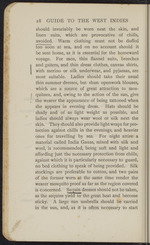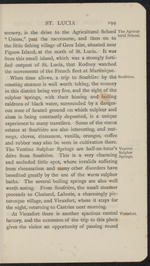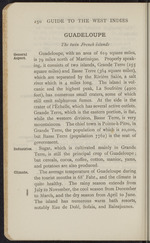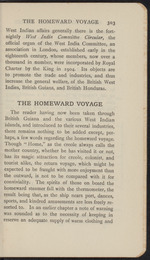| 1 |
 |
“...28 GUIDE TO THE WEST INDIES
should invariably be worn next the skin, and
linen suits, which are provocative of chills,
avoided. Warm clothing must not be doffed
too soon at sea, and on no account should it
be sent home, as it is essential for the homeward
voyage. For men, thin flannel suits, breeches
and gaiters, and thin dress clothes, canvas shirts,
with merino or silk underwear, and pyjamas, are
most suitable. Ladies should take their usual
thin summer dresses, but shun openwork blouses,
which are a source of great attraction to mos-
quitoes, and, owing to the action of the sun, give
the wearer the appearance of being tattooed when
she appears in evening dress. Hats should be
shady and of as light weight as possible, and
ladies should always wear wool or silk next the
skin. They should also provide light wraps for pro-
tection against chills in the evenings, and heavier
ones for travelling by sea. For night attire a
material called India Gauze, mixed with silk and
wool, is recommended...”
|
|
| 2 |
 |
“...sulphur and
alum is being constantly deposited, is a unique
experience to many travellers. Some of the cocoa
estates at Soufrière are also interesting, and nut-
megs, cloves, cinnamon, vanilla, oranges, coffee
and rubber may also be seen in cultivation there.
The Ventine Sulphur Springs are half-an-hour’s Ventine
drive from Soufrière. This is a very charming f^ngs.
and secluded little spot, where invalids suffering
from rheumatism and many other disorders have
benefited greatly by the use of the warm sulphur
baths. The several boiling springs are also well
worth seeing. From Soufrière, the small steamer
proceeds to Choiseul, Laborie, a charmingly pic-
turesque village, and Yieuxfort, where it stays for
the night, returning to Castries next morning.
At Vieuxfort there is another spacious central vieuxfort.
factory, and the extension of the trip to this place
gives the visitor an opportunity of passing round...”
|
|
| 3 |
 |
“...but Basse Terre (population 7762) is the seat of
government.
Sugar, which is cultivated mainly in Grande
Terre, is still the principal crop of Guadeloupe;
but cereals, cocoa, coffee, cotton, manioc, yams,
and potatoes are also produced.
The average temperature of Guadeloupe during
the tourist months is 68° Fahr., and the climate is
quite healthy. The rainy season extends from
July to November, the cool season from December
to March, and the dry season from April to June.
The island has numerous warm bath resorts,
notably Eau de Dolé, Sofaia, and Bainsjaunes....”
|
|
| 4 |
 |
“...attraction for creole, colonist, and
tourist alike, the return voyage, which might be
expected to be fraught with more enjoyment than
the outward, is not to be compared with it for
conviviality. The spirits of those on board the
homeward steamer fall with the thermometer, the
result being that, as the ship nears port,
sports, and kindred amusements are less freely re-
sorted to. In an earlier chapter a note of warning
was sounded as to the necessity of keeping in
reserve an adequate supply of warm clothing and...”
|
|
